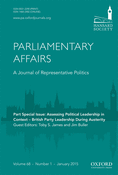-
Views
-
Cite
Cite
Stuart N. Soroka, Olga Redko, Quinn Albaugh, Television in the Legislature: The Impact of Cameras in the House of Commons, Parliamentary Affairs, Volume 68, Issue 1, January 2015, Pages 203–217, https://doi.org/10.1093/pa/gst017
Close - Share Icon Share
Abstract
The introduction of television cameras in legislatures met, in many countries, with serious debate about the potential benefits and costs of broadcasting legislative debate. There were concerns about tendency for cameras to produce less focused, more attention-seeking behaviour amongst party members, and especially leaders. This work draws together the literatures on televising debates, and on personalisation, to explore the impact of introduction of cameras in the Canadian House of Commons. Analyses are based on content analytic database of over 11,000 questions asked from 1957 to 2004; they suggest no discernible impact of cameras on House debates. These results are discussed as they pertain to both the current literature on personalisation, and the design of legislative institutions and communication policies.




